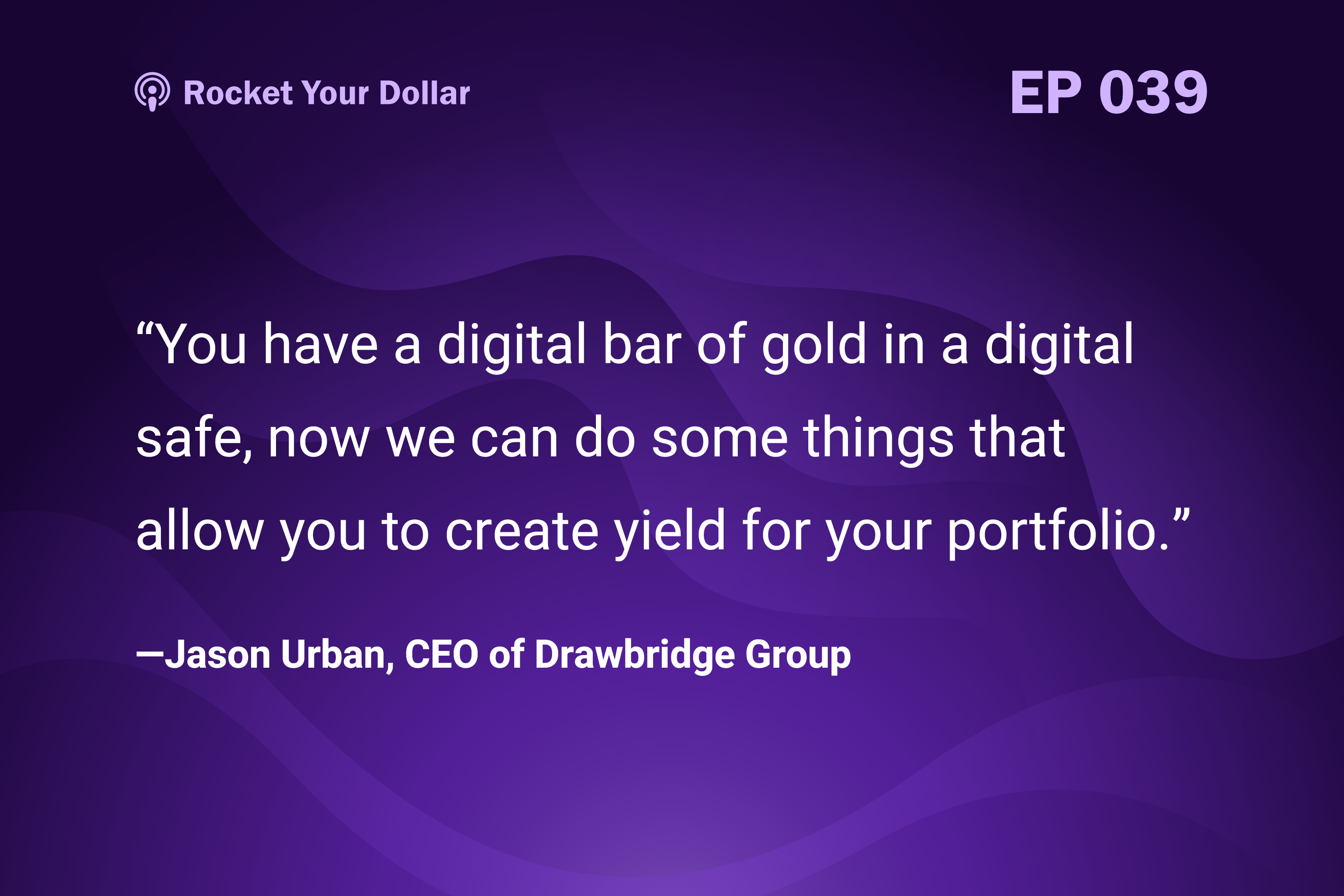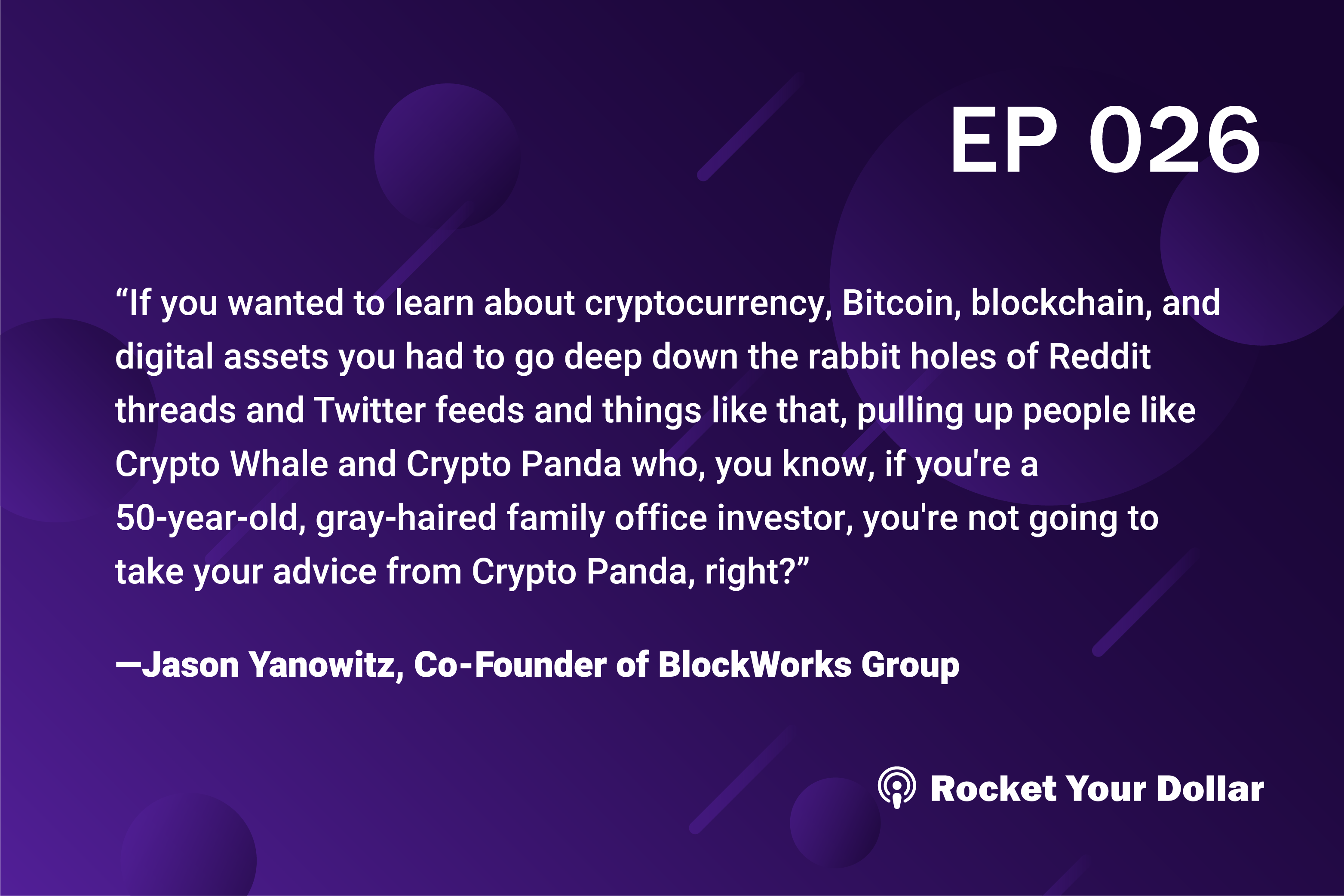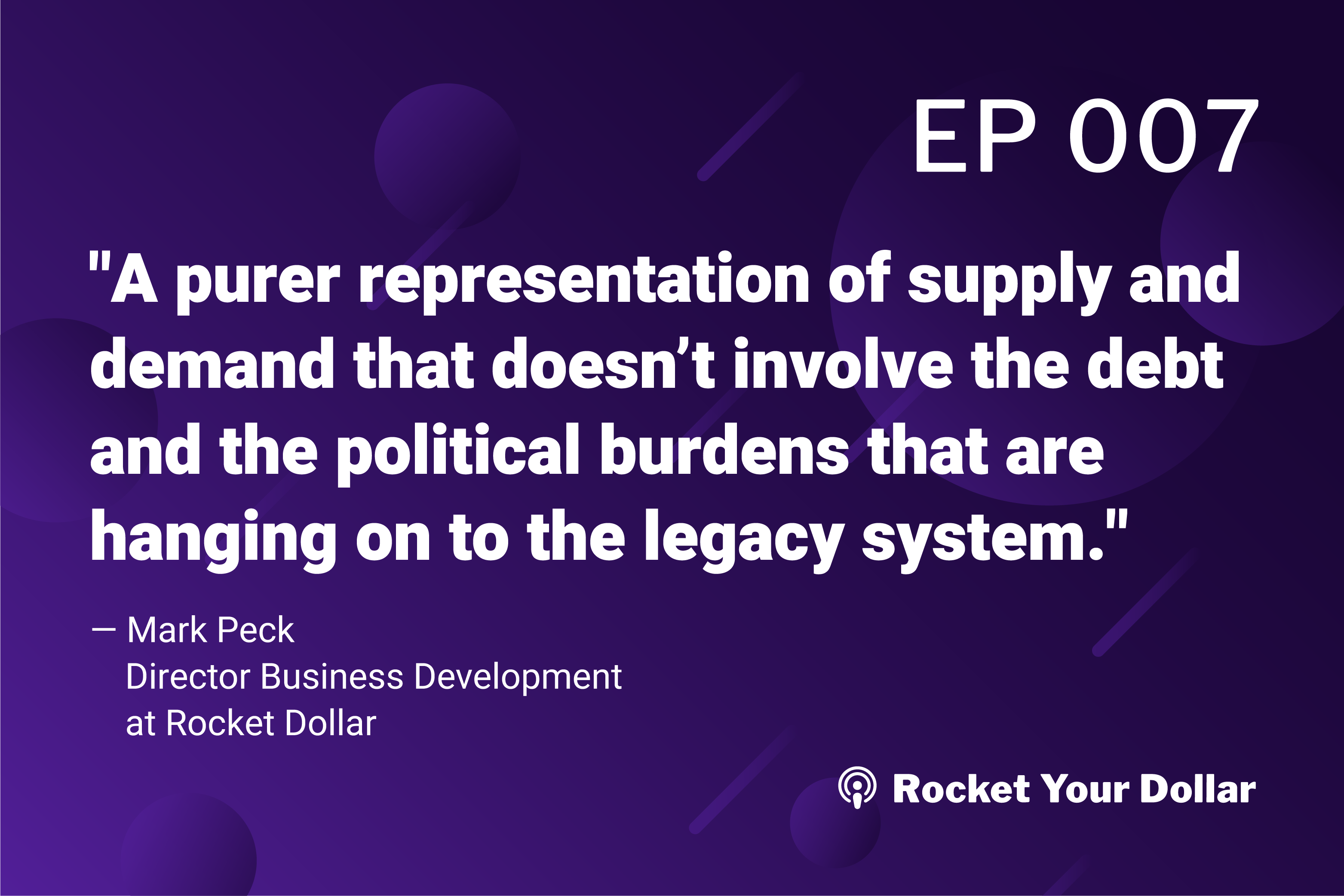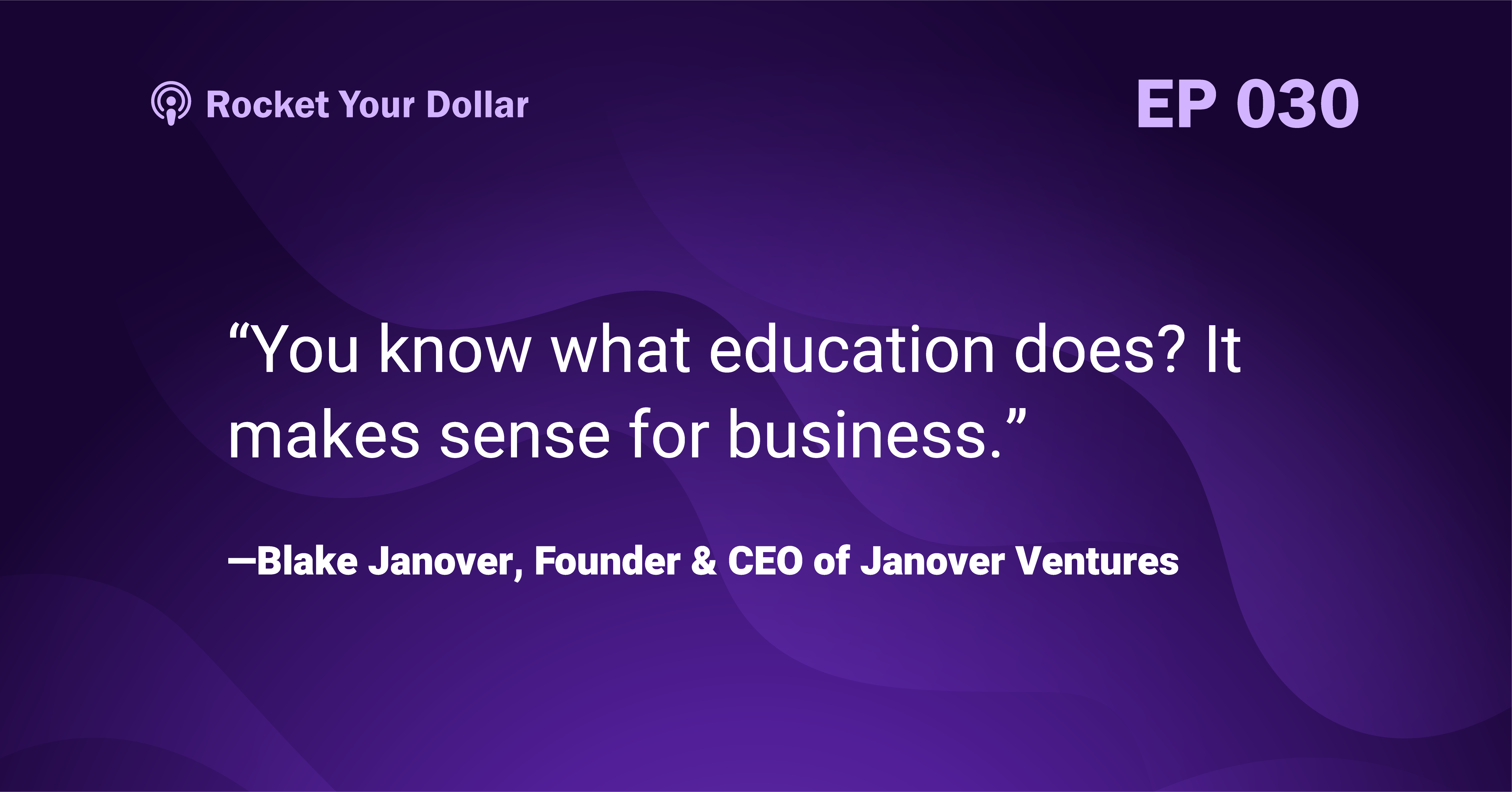Rocket Your Dollar Ep. 26: Teaching Blockchain and Crypto the Responsible Way
Two years ago, if you wanted to learn about stocks, bonds, currencies, commodities, you'd go on Google, and you've got a bunch of different ways to...
16 min read
 The Rocket Your Dollar Podcast
:
May 13, 2020
The Rocket Your Dollar Podcast
:
May 13, 2020

Jason Urban, CEO of Drawbridge Group, has innovated a market & credit-based approach to crypto lending, creating a high level of versatility and yield within the asset.

Thomas Young:
Hi, everyone. Welcome back to the Rocket Your Dollar podcast. Today, I have with me Jason Urban. Jason is the CEO of DrawBridge Lending. Prior to coming to DRW, Mr. Urban ran the Goldman Sachs equity volatility market-making business from 2000 to 2009, engaging in similar volatility arbitrage and direction strategies while becoming familiar with the protocols of the OTC and interdealer market. Before working with Goldman Sachs, Mr. Urban broke into the business at Merrill Lynch in their equity specialist group, and Mr. Urban has an MBA from the University of Chicago Booth School of Business and a bachelor's in finance and marketing from Georgetown University. Jason, thank you so much for being on the show.
Jason Urban:
Thanks for having me. It's a pleasure to be here.
Thomas Young:
Absolutely. Just to kick it off, you have a very interesting background. Tell me a little bit about your time at Goldman and what exactly the equity volatility market-making business is.
Jason Urban:
Yeah. A mouthful there, right? What that business was or is, is when people want to trade options on indexes or hedge portfolios, hedge broader risks, they will come and trade with large banks, especially when it's sized larger than what might normally be digested in the market. You get a variety of sizes of orders, and it's options trading. But at the end of the day, my role was to take the low end of that business. It kind of goes through a series of filters, if you will, where different desks or different businesses within the firm had an opportunity to take that flow and trade against it. Then at the end of the day, ultimately it had to be disposed of. I kind of was the disposer of all the flow that no one wanted or no one could do anything with at a given time.
It ended up being us taking proprietary positions, learning about relative value trades, and it was in volatility-based products like the S&P 500 or the VIX or variant swaps or things related to that. I did that. I was there from 2000 to 2009. In 2009, I left and went and started the same business at DRW, which is a privately held professional trading group here in Chicago. I'm doing the same things, was there for another roughly 10 years until I left to start DrawBridge Lending or DBL about a year and a half ago with a couple of partners.
What that business has always been is finding ways to use market structure, to use flows in the marketplace to create value, create value for yourself via prop trading, or value for clients via structured products or other offerings that they can use.
Thomas Young:
Fantastic. Just for me to get the timeline straight, so 2000-2009 Goldman Sachs, then 2009 to 2000 roughly '19, '19 DRW, and then DrawBridge Lending. Correct?
Jason Urban:
That is correct.
Thomas Young:
Awesome. DrawBridge lending right now is the focus. It's what you're the CEO of, and it's what you're working on a full time, right?
Jason Urban:
That is correct. This is what I do every day. I show up here. We are located in Chicago in the Board of Trade Building. I get to show up every day and see all the same familiar faces I saw for the last 20 plus years, but just doing something completely different now.
Thomas Young:
Fantastic. For people not familiar, which I think is most of us and we will be familiar by the end, what is DrawBridge Lending and what is it exactly that you guys do?
Jason Urban:
DrawBridge Lending started lending fiat against digital assets called Bitcoin. Over time, we still do that and it's very interesting in the IRA and Self-Directed space. But over time we've evolved to not only doing lending but also providing structures or vehicles where people who hold digital assets can produce a yield for their account. You're not like holding a dead asset where you have a bar of gold in a safe. You have a digital bar of gold in a digital safe, now we can do some things that allow you to create yield for your portfolio.
Thomas Young:
Okay, fantastic. It's all around, as the name would imply, lending against that asset. Correct?
Jason Urban:
The fiat lending part is. The DBL Digital, which is kind of an offshoot, is basically... It's for people to create income on their assets. Lending is one aspect of that. But as you'll see as we discussed, there's a lot of trading that also goes into it on the customer's behalf.
Thomas Young:
Right. Okay. Interesting. Let's split it in two and we'll talk about the lending side of it. Maybe we can do a quick case study of someone that comes to you and who are the types of people that come to you on the lending side.
Jason Urban:
To start with, all of our clients have to be ECPs. It's an accredited investor. But what ends up happening is it's a wide variety of people who come to us looking for a loan. We have clients who have Self-Directed IRAs in which they hold digital assets and require cash. We have miners who are mining digital assets and want to monetize that, and we have long-term holders who look at this and say, "I need the cash, but I don't want to sell the asset." What we end up providing are non-recourse, non-margin call loans, which is why we are the only lender currently that is eligible to make loans against a Self-Directed IRA because there is a non-recourse component to what we're doing. The way the process works is it's fairly simple.
If a client has Bitcoin trading at $10,000 and wants to borrow $5,000 for whatever reason, they want to buy more Bitcoin, they want to make another investment in something, they have a short-term need for cash, that's kind of the client's decision that we don't have a horse in that race. But what we'll do is we'll say, "Okay, Bitcoin's trading $10,000. We will lend you $5,000." What we do is we create a collar structure. Without getting too far into the options theory, we end up buying a put and selling a call on the client's coin for the client and then lending them money at a very low-interest rate. It's a structured product in a traditional sense, but right now we generally loan money to clients between one and 3% on their holdings.
In this case, with Bitcoin trading $10,000 and the client wanting $5,000, we will lend them the $5,000 at say 1%, we will buy the 5,000 put, which protects the person giving us the cash, we're relending it, and then we'll go out and we'll sell a call. The call we're selling is generally like say the 15,000 calls. It's about equidistant away. If a client wants a 50 LTV loan, loan-to-value, we will put a ceiling on that at about 150%. What that looks like then to the client is they have a non-recourse, non-margin call loan so they can walk away from it. If Bitcoin in that period, and generally speaking, our loans are two to four months, in that period, Bitcoin goes up 50%, the client participates 100% up to the strike.
Then above the strike, they no longer participate in the advancement of the value of Bitcoin, but they don't lose their Bitcoin. Their Bitcoin never goes away. Let's just use an example of a client who has 10 Bitcoin and would like to borrow 10 Bitcoin currently trading at $10,000. They have $100,000 in Bitcoin. They'd like to borrow $50,000 because they want to buy IBM stock in their IRA, and I'm just picking... Full disclosure, we don't have anything to do with IBM, but they want to buy IBM stock. They deposit their Bitcoin in a custodial account. It's a third-party custodian. The coin never comes to us. It always goes to a third. From there, we will issue them a loan for $50,000. Generally speaking, we wire the money to whatever account the client directs us to and they get the money.
In this case that we just talked about, we would then buy the 5,000 put. To protect ourselves, we buy it 10 times, and we'd sell the 15,000 calls 10 times. If Bitcoin is anywhere between zero and 15,000 in the next 90 days, because let's just say this is a 30 or a 90-day loan, the client can simply repay the loan if there are no adverse effects. If Bitcoin goes to say $16,000, the client started with assets worth $100,000 that are now worth $160,000, but they owe the counterparty $10,000. In that example, we would sell a portion of one Bitcoin to satisfy the calling piece. The client would maintain their 9.2 Bitcoin, and they would have a value of $150,000.
From that standpoint, they got to borrow the 50 grand they wanted to, as well as participate in the rally off, and they got to belong to the IBM stock, which they wouldn't have bought if they were just in Bitcoin.
Thomas Young:
Okay. Wow, that makes sense. I guess it just depends on the... I mean, the volatility of Bitcoin is high and so you don't know where it's going to be, but it sounds like the range is high enough to where you can participate if it does rally. You have some pretty compelling participation while still being able to do other things, right? That sounds like a pretty good win-win for me.
Jason Urban:
Yeah. We work with the client. Thomas, just to be clear, it isn't us saying, "Hey, this is what we have to offer. Take it and leave it." If the client comes and says, "Hey, I think Bitcoin's going to 16,000. What can you do," then we say, "This is what we can offer with the suite of products that we have." If you think about ourselves, we're simply just a factory, making structured products to suit client's needs. Bitcoin because of the volatility allows us a pretty good field of options, no pun intended, to offer clients to monetize their position and take advantage of that.
Thomas Young:
Right. No, that makes perfect sense. Just curious, like how much leverage do you allow customers to take?
Jason Urban:
Well, again, because this is an asset-backed loan, the client can take as much leverage as they want. The issue becomes it's just the call strike, right? Because it's about equidistant, it varies. It's a market-based product. But in the example we just used with Bitcoin at 10,000 doing a $5,000 loan that corresponded with the $15,000 ceiling. If the client said, "Hey, I want a $9,000 loan," the ceiling is going to be closer to 11,000, right? It's about a thousand dollars either way and that's just the current market structure. We let the clients decide what they want to do and how much leverage they want to take, but we can't go obviously because there's one Bitcoin, we can't lend you $11,000 on a $10,000 Bitcoin, but we can go pretty close to...
If it's $10,000, we can lend you $9,500. I wouldn't recommend that, but that's not to say that it can't be done.
Thomas Young:
Right. If someone is just gung ho about something else and they don't care about what Bitcoin does, it might work for them, but it's not necessarily what's best, right?
Jason Urban:
Right. If you think about it, if you didn't want to hold Bitcoin, you could just sell Bitcoin and take your $10,000 and go somewhere else.
Thomas Young:
Right. Yeah. If you're looking to participate in something else without taking advantage of the asset, you might as well just sell the Bitcoin and move on, right, which makes sense.
Jason Urban:
Exactly.
Thomas Young:
That's interesting. How did you decide to start this? Where did the idea come from to start working on this having had the career that you've had?
Jason Urban:
Well, if you think about this, this is a common structure in every other commodity in the world. ADM and Cargill do this with farmers all the time. ExxonMobil does it with oil, Wildcatters. This is not unusual. It's just nobody's doing it in Bitcoin. When we look at the space, you can kind of look at it and say, "What do people need?" Well, there are currently lenders in the digital asset space. There are a lot of trading groups in the digital asset space, but nobody's doing structured products like this and giving clients the ability to do that. We kind of looked at that and said, "The market needs something like this. We have the background and the expertise to do this. We're all market veterans."
This is a way to kind of bring old market ideas to a new asset class, and then that was kind of the impetus for the name, right? DrawBridge. We want it to be the bridge or the draw bridge from these traditional pools of liquidity into this new emerging asset class, which is going to change the way business is done going forward.
Thomas Young:
I think that makes perfect sense. I'm curious, why do you think that it hadn't been done before? Was it just because the space is so new and you guys were looking for something like this? Because some expertise needs to go. Like not anybody can just go and start something like this, but why do you think that it wasn't a thing?
Jason Urban:
Well, I think for a couple of reasons. One, the space is very new and I think that that has a lot to do with it. Two, traditional options, guys like me, look at the space and would say, "Hey, why don't I just trade for my account and make money doing that," which don't think hadn't crossed our minds at some point, but then we looked at it and said that this is something that can be so much bigger if done correctly, and that was kind of why we did this. Then when you take on the additional legal and regulatory issues that come with this when I say issues, we're a non-bank lender in 49 states, so we have every state regulator looking at us. In addition to that, we are regulated by the NFA and the CFTC as a commodity pool operator and a commodity trading advisor.
To do it correctly, you need to spend a fair amount of money. There's a big regulatory cost associated with that. I think that's why other people, it's a deep moat there, whether it's getting the lending licenses per state or getting the different registrations with the federal commissions, it's really important to do it correctly so that people when they do participate in this know that this isn't just people who are looking out for themselves. We are obligated to follow the same rules that everybody else is and we're doing it that way.
Thomas Young:
Yeah, and that makes perfect sense. I love businesses that have those sorts of models. I know that for us at Rocket Dollar when we started in a similar vein, these regulatory agencies, now granted not as many as you guys, but they need to make sure that people are safe and that what we're doing is above board and the people are safe, right? I mean, it's a Self-Directed account. There's an opportunity for investments to go up and down, right? Same as with you guys, but at the core of what you're doing, the service you're providing is safe. The company's not going to put you in trouble. You can get yourself in trouble.
Jason Urban:
Exactly. Exactly. From our perspective, we look at it and say, "We've checked all the legal reg boxes." We work closely with our regulators to make sure that what we're offering to the clientele is completely compliant with all the current rules and regs, and offer our guidance as well to them in this new space and say, "Hey, you should consider this or think about this because this is a risk." We're working closely with regulators, as well as making sure that all your compliance docs are in order is important. I think that that allows you to grow as opposed to just kind of doing it willy-nilly and something bad happens.
Thomas Young:
Right, and that mistake or that something bad happening could end up costing you more than the process of getting certified and going through working with regulators, which is expensive, but that mistake can be a lot more expensive.
Jason Urban:
Yes, exactly. Exactly.
Thomas Young:
As you said, you guys are regulated or you've worked in 49 states and your products live. What are you guys working on now? What's the second phase or what are you guys working on currently and going forward this next year?
Jason Urban:
The other product that we've seen a lot of success with and we're currently spending a fair amount of time on is the series fund product. Similar to the lending product, a client can instead of taking a loan, put their Bitcoin to work. What they can do is open their own fund, so their own series funds and the way that's structured is it's the client's own account and that account is 100% owned. Similar to their Self-Directed IRA, it's 100% owned by them. It's got its own tax ID, gets its own K-1, goes through that entire process. Then what we do is we look at structures in the market and they're fairly simple. I mean, we're talking about a call overwrite or a collar structure or perhaps a call spread that allows the client to participate and pay themselves yield.
The same structures that we're using to buy down the interest rates on the loan product, we're also using to allow clients to pay themselves a yield on this asset that they believe in. At the end of the day, the client picks the structure they want, they sign up in the series fund, similar to opening an account anywhere else, and then they pick the structure they want with the assets that they want to deploy. We've seen a lot of success in that Self-Directed IRA space with this with people who own say Bitcoin and are looking to pay themselves 12, 13, 14% based on the structure that they choose. We're pretty open about what we're doing. We're very open about what we're doing and how the clients are achieving those yields.
We advise them and help them put together structures that turn that debt asset into a yield generating asset without taking the risk of lending your coin out. Currently, when you lend your coin out in this space, that coin gets rehypothecated. You lend your coin to one of the lending groups out there, they then take your coin and they'll lend it to somebody else, who lends it to somebody else. The problem with that is you create this collateral chain and there are massive rehypothecation risks. Because our coin always goes into cold storage and stays in cold storage, the client knows exactly where their coin is all the time. They may be bounded with certain options trades, but they know what that defined risk is.
If you lend your coin to somebody and Bitcoin triples in value, well, there's a good chance that somebody is going to default on a coin loan and you're going to be left without your coins. You're sure to call that you don't even know the duration nor the strike price on, where we sit there and tell you this is exactly what your risks are, this is exactly why you're getting paid 20% to own Bitcoin.
Thomas Young:
Right. Yeah. It's a lot more closely held if you will, I mean. Instead of it being two or three levels of lending away, it's much closer and much more accessible and the risks are much more defined if you will.
Jason Urban:
Exactly. If it's your series fund, that series fund has an account at a custodian, which we pay for, and that series fund owns the custodial account and the coin sits in that account. So you know precisely where your coin is. It doesn't get moved to an exchange. It doesn't get lent to some nefarious character. It sits in cold storage at the custodian of your choosing.
Thomas Young:
Right. I think that a lot of people, especially people that are newer to the cryptocurrency space, appreciate it because it seems... Or at least to me in this space, there's a lot of uncertainty and there's a lot of different players. There's, frankly, stories of fraud and things like that where people seem to be cautious in the space because it already carries such high risk, that in people's mind these sort of new assets, these digital assets, that having the peace of mind of knowing exactly what's going on with your coin I think is really important to a lot of people.
Jason Urban:
Yup, without a doubt. We try to demystify some of the things around or some of the issues around digital assets. It's an asset no different than buying a bar of gold or a bushel of corn. At the end of the day, we can service clients in two ways. One, we can buy Bitcoin for them and put that in the account, or two, the client who has Bitcoin or other digital assets can show up and pledge that and send that to their custodial account and open an account that way. At the end of the day, we can help the client work through some of the unknowns and explain this is how you want to buy your Bitcoin, this is where you want to hold your Bitcoin, and this is what we can do to help you work with that in the universe. That kind of is how we look at the space, make it as easy as possible for someone to do what they want to do.
Thomas Young:
Right. No, that makes perfect sense. You mentioned at the beginning of the show that most of your clients are accredited, investors?
Jason Urban:
Yes. Because of how we structure this, we need to deal with accredited investors. That's the government getting us to make sure we're checking all the boxes and allowing them to understand what they're doing and how they're doing it.
Thomas Young:
Yeah. It's one of the things that we come across with a lot of our partners and the people that we talk to is that accreditation is still a thing. It's frustrating for a lot of people because accredited investors represent a small percentage of people, but...
Jason Urban:
Interestingly enough, Thomas, because this is CFTC regulated as opposed to SEC-regulated, the level of accreditation is a little bit different. I would recommend people when they come to us to sign up, we give them a laundry list. You effectively can use your home, you can use intellectual property, you can use other things that don't necessarily get you value in the accredited universe, the CFTC does count and allow you to apply towards your hurdle. It's a little bit different and it might be more helpful for somebody who might not qualify under an SEC guidance but may qualify under CFTC just because that's what the rules and regulators wrote. We do work with clients to help them identify if they qualify.
Thomas Young:
Right, that makes sense and that's good to know and important for our listeners because there are different types of... When people think of accreditation, most of the time it's SEC accreditation. It's the million-dollar investable assets and then some income requirements, but there are different types. It's good that you mentioned that. If anybody listening is interested in DrawBridge Lending, it's worth going to them if you're unsure because they'll walk you through the process.
Jason Urban:
Absolutely. We will make sure that you qualify under the rules of our that we're dealing with, and that also impacts the coins that we can offer loans on, as well as the investment product too because some are considered securities, and some are considered commodities by the CFTC. We don't want to run afoul of a regulator and we certainly don't want our clients to run afoul of a regulator. We walk you through that and are very knowledgeable and transparent on that.
Thomas Young:
That's fantastic. Jason, if somebody is interested in working with you guys or learning more about what you guys are doing, what's the best way to get in touch with either your team at DrawBridge or with you? How can someone get started with you guys in this process?
Jason Urban:
The best way is to go to DrawBridgeLending.com and request some information. From there, we can get you the appropriate documents, be it loan documents or fund documents, because they are different. Once you've onboarded with us, you've now qualified and passed AML KYC, so that's Anti-Money Laundering, Know Your Customer rules, then we can offer both products interchangeably. But in order for the initial contact, pick a program, come on onboard, and we will start the dialogue.
Thomas Young:
Fantastic. Jason, I want to thank you for coming on today and sharing what you guys are doing with us. It's really interesting. I know we have a lot of crypto enthusiasts as clients in our world. It's a space that people in our team are interested in. It's very daunting to me personally, but I know that there's a tremendous amount of excitement. I want to thank you for coming on today and sharing a little bit about what you guys are doing.
Jason Urban:
Absolutely. Thanks for having me. Again, if anybody's interested, please reach out. Even if it isn't a program for you today, we can help point you in the right direction. We're very much about educating and helping people learn about this asset class.
Thomas Young:
Fantastic. Jason, thank you so much.
Jason Urban:
Thank you very much.

Two years ago, if you wanted to learn about stocks, bonds, currencies, commodities, you'd go on Google, and you've got a bunch of different ways to...

Mark Peck, Director of Business Development at Rocket Dollar and cryptocurrency investor gives a brief overview of the benefits of crypto in a...

The investment space is always shifting. Now, in 2020, there are countless options for investors. There's new tools, new processes, new technology....